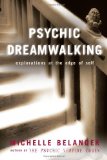 Psychic Dreamwalking: Explorations at the Edge of Self, by Michelle Belanger
Psychic Dreamwalking: Explorations at the Edge of Self, by Michelle Belanger
Weiser Books, Weiser Books, 205 pp. (incl. appendices, excl. bibliography), 2006
Dreaming is something we all do, whether we consciously remember our dreams our not. Belanger defines dreamwalking as “the art of sending forth a part of the self in order to make contact with others through the medium of dreams.”1 I like her approach to the material; she frequently uses anecdotes to describe her personal experiences and explorations, and then lucidly deconstructs them to illustrate her points.
A wide variety of exercises are offered, from the more basic, such as creating dream haven, a ‘gate of dreams’ (essentially a ‘portal’ through which is the dream world), and fashioning an eidolon (one’s dream-self), as well as more complicated explorations, such as creating dream landscapes and techniques for lucid dreaming. At the end of each exercise brief checklists aid the reader in determining whether or not one has performed the exercise successfully, offering suggestions for what to look for and tips to correct technique.
The practice of keeping a dream journal is recommended. Belanger even includes excerpts from her own journal along with analysis, which will prove immensely helpful to those new to it. She often recommends a cautious approach to success, sensibly stressing that unless something is verifiable, one should be hesitant about taking anything that occurs in the dream world as fact.
The subject of ethics is introduced, especially in describing visiting others, as well as touching upon psychic vampirism, psychic attack, and psychic defence, the latter of which might be somewhat familiar to those who have read her previous book, Psychic Vampire Codex.
My initial impression is that the chapters may have been written independently, and only later strung together This would account for why the exercises don’t seem to build directly upon one another in a linear fashion, and why so some passages seem repetitive at times. As a result, I would recommend the reader first go through the entire book prior to attempting any of the exercises found within. For example, only after discussions on creating on eidolons, dream landscapes, dream gates, etc. is the subject of dream journaling fully explored, and the new student will likely want to record these early experiences to track progress. Once the concepts have been initially digested, I suggest the reader then go back and review the chapter and perform the exercises.
Psychic Dreamwalking provides an excellent introduction to dream work, with effective exercises and practical tips to help keep one on track, this guide also offers much which is not found in the average new age book on the subject. It would make a great addition to any library, and the practical applications provide simple techniques useful to any magician looking to explore their own dream territory.
- p. 23 [↩]








